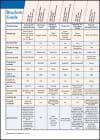By Mike Fratantoro
You know those orthodontic brackets, elastic rubber bands, and power chains you’re about to attach to your patient’s teeth? They’re actually a fashion accessory for your wrist. Just use your imagination. Don’t believe me? Then maybe you’ll take a doctor’s word for it.
In this month’s edition of Business Wired, Orthodontic Products spoke with Marc Lemchen, DMD, an orthodontist in New York City, who partnerned with his colleague Jen Salzer, DDS, to turn some simple orthodontic materials into a successful fashion product and side business called Braced-Lets.
How did you get involved in managing a side business?
Marc Lemchen, DMD: I was one of the original founders of Dolphin Imaging & Management Solutions, my first business, in 1988. Dolphin was an idea that occurred to me while at the AAO convention. We wrote a business plan and were somehow lucky enough to get venture capital. From there we went on to see Dolphin become the successful company it is today.
Tell us a little about Braced-Lets. How did you come up with the idea?
Lemchen: Jen Salzer and I have worked together for many years, and one of the things we have most enjoyed is sharing innovative and fun ideas, and actually pursuing some of them. Years ago, we marveled at the fact that many of our patients were wearing these black rubber bracelets that were actually just large “O” rings. So I asked myself, why couldn’t we make bracelets out of our elastic chains? I took a piece of chain and used one bracket to join the two ends. Jen took it and added another bracket every few holes and added single “O’s” of different colors. It was cute, and there were so many different designs and combinations we could make. We were amazed. We showed them to a few patients who loved them, and we were hooked on the idea.
You said that, “The idea is the easiest part. Making a successful product is the hard part.” What was the biggest challenge to starting up this project?
Lemchen: Over the years, we have come up with so many good ideas. To take an idea and make it into a product, first of all you have to be able to produce it. Then you have to be able to market it. Once we had the Braced-Lets concept, we had to formalize a design, develop a way of manufacturing them that was cost-effective, obtain trademarks and design patents, and decide on a marketing and sales plan. We located manufacturers and found one who would work on making a prototype. We had to cast the brackets as well as make chain that would be as durable as true orthodontic chain, but was much less costly. We went through a number of design changes before coming up with a workable combination. Then, all of the materials, including each individual color chain, had to be tested for safety by independent laboratories. This part of the process was very involved, so this is an abbreviated version to be sure.
How were you able to successfully manage your orthodontic practice and Braced-Lets at the same time?
Lemchen: Jen and I both kept in mind that orthodontics is our profession. Very early in the process, Jen’s sister, Lisa—a very successful jewelry designer—joined us on the project. In addition to design input, Lisa had an organization with access to great public relations, which put our Braced-Lets in publications literally all over the world, including The New York Times, Harper’s Bazaar, many blogs, and more.
We have now partnered with a major toy manufacturer to handle sales outside of the orthodontic profession. To go to the retail market, we needed to learn much more about packaging and displays, as well as bar coding. How many orthodontists get to learn what a stock keeping unit (SKU) is?
Did your business experience as an orthodontist facilitate starting up your own small business?
Lemchen: I believe that every thing in life is built on relationships at all levels. Jen and I have built our practice on making relationships—not only with dentists, but by knowing who knows who in our practice. It is fun for us to make these connections. This same concept helped us to make the contacts we needed to bring our Braced-Lets from an idea to a reality.
Of course, it was orthodontics—our everyday profession — that provided us with the capital to boot-strap this product into a business.
What has your experience with Braced-Lets taught you about starting and operating a small business? What recommendations do you have for other orthodontists wishing to do the same?
Lemchen: I have been fortunate to have started a few businesses, obtained patents, and seen some of my ideas succeed. I have learned that I am probably best at what I do as a profession—orthodontics—and I think it is wise to keep that in mind.
We have learned that even under the best of circumstances, everything takes much longer then you think it will. There is no overnight success, although Braced-Lets was close to one.
You likely cannot do this on your own. Look for people with expertise: patent attorneys, public relations experts, packaging engineers. You must aim to do everything as best as you can the first time. OP






